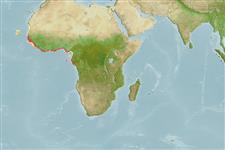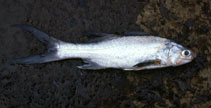Polydactylus quadrifilis (Cuvier, 1829)
Giant African threadfin
Adicionar as suas observações no Fish Watcher
| Native range | All suitable habitat | Point map | Year 2050 |

|
| This map was computer-generated and has not yet been reviewed. |
| Polydactylus quadrifilis AquaMaps Data sources: GBIF OBIS |
Adicionar o seu Fotografias e vídeos
Pictures | Imagem do GooglePolydactylus quadrifilis
Picture by Klimpel, S.
Pictures | Imagem do GooglePolydactylus quadrifilis
Picture by Klimpel, S.
Senegal country information
Common names:
Capitaine, Elanc, Itiékem
Occurrence: native
Salinity: brackish
Abundance: | Ref:
Importance: | Ref:
Aquaculture: | Ref:
Regulations: | Ref:
Uses: live export: yes;
Comments: Occurs in the Sine-Saloum Estuary, Casamance and Senegal rivers (Ref. 28587). Also Ref. 4340, 33587, 57343, 81658.
National Checklist:
Country Information: https://www.cia.gov/library/publications/resources/the-world-factbook/geos/sg.html
National Fisheries Authority: http://www.refer.sn/sngal_ct/eco/oeps/
Occurrences: Occurrences Point map
Main Ref: Daget, J., 2003
National Database:
Occurrence: native
Salinity: brackish
Abundance: | Ref:
Importance: | Ref:
Aquaculture: | Ref:
Regulations: | Ref:
Uses: live export: yes;
Comments: Occurs in the Sine-Saloum Estuary, Casamance and Senegal rivers (Ref. 28587). Also Ref. 4340, 33587, 57343, 81658.
National Checklist:
Country Information: https://www.cia.gov/library/publications/resources/the-world-factbook/geos/sg.html
National Fisheries Authority: http://www.refer.sn/sngal_ct/eco/oeps/
Occurrences: Occurrences Point map
Main Ref: Daget, J., 2003
National Database:
Common names from other countries
Classificação / Names Nomes comuns | Sinónimos | Catalog of Fishes(Género, Espécies) | ITIS | CoL | WoRMS | Cloffa
> Carangaria/misc (Various families in series Carangaria) > Polynemidae (Threadfins)
Etymology: Polydactylus: Greek, poly = a lot of + greek, daktylos = finger (Ref. 45335).
More on author: Cuvier.
Etymology: Polydactylus: Greek, poly = a lot of + greek, daktylos = finger (Ref. 45335).
More on author: Cuvier.
Environment: milieu / climate zone / depth range / distribution range Ecologia
marinhas; Água doce; estuarina demersal; intervalo de profundidade 15 - 55 m (Ref. 10799). Tropical; 22°N - 5°S, 26°W - 13°E (Ref. 57343)
Distribuição Países | Áreas FAO | Ecossistemas | Ocorrências | Point map | Introduções | Faunafri
Tamanho / Peso / Idade
Maturity: Lm ? range ? - ? cm
Max length : 200 cm TL macho/indeterminado; (Ref. 57402); common length : 150 cm TL macho/indeterminado; (Ref. 3659); peso máx. Publicado: 75.0 kg (Ref. 7386)
Max length : 200 cm TL macho/indeterminado; (Ref. 57402); common length : 150 cm TL macho/indeterminado; (Ref. 3659); peso máx. Publicado: 75.0 kg (Ref. 7386)
Descrição breve Chaves de identificação | Morfologia | Morfometria
Espinhos dorsais (total) : 9; Raios dorsais moles (total) : 12 - 13; Espinhos anais: 3; Raios anais moles: 11 - 12. Diagnosis: pectoral fin with 4 threadlike filaments (Ref. 57402, 81658). Pectoral fin inserted very low on body, generally somewhat longer than upper part of fin (Ref. 57402).
Occurs in shallow coastal waters, over sandy and muddy bottoms, sometimes in brackish habitats (Ref. 57343, 81658). Enters estuaries (Ref. 57402), occasionally caught in fresh water (Ref. 57402, 81658). Very large specimens are only found in marine waters (Ref. 81658). Feeds on crustaceans and fishes (Ref. 10799, 81658). Flesh fairly tasteful (Ref. 57402).
Life cycle and mating behavior Maturidade | Reprodução | Desova | Ovos | Fecundidade | Larvas
Referência principal
Upload your references | Referências | Coordenador | Colaboradores
Motomura, H., 2004. Threadfins of the world (Family Polynemidae). An annotated and illustrated catalogue of polynemid species known to date. FAO Spec. Cat. Fish. Purp. Rome: FAO. 3:117 p. (Ref. 57343)
Categoria na Lista Vermelha da IUCN (Ref. 130435: Version 2024-2)
Preocupação menor (LC) ; Date assessed: 15 July 2014
Ameaça para o homem
Harmless
Utilização humana
Pescarias: espécies comerciais; peixe desportivo: sim
FAO(pescarias: produção; publication : search) | FishSource | Sea Around Us
Mais informação
Population dynamics
Parâmetros de crescimento
Max. ages / sizes
Length-weight rel.
Length-length rel.
Frequência de comprimento
Mass conversion
Recrutamento
Abundância
Parâmetros de crescimento
Max. ages / sizes
Length-weight rel.
Length-length rel.
Frequência de comprimento
Mass conversion
Recrutamento
Abundância
Life cycle
Reprodução
Maturidade
Fecundidade
Desova
Spawning aggregations
Ovos
Desenvolvimento dos ovos
Larvas
Dinâmica larvar
Reprodução
Maturidade
Fecundidade
Desova
Spawning aggregations
Ovos
Desenvolvimento dos ovos
Larvas
Dinâmica larvar
Anatomy
Área branquial
Brain
Otolith
Área branquial
Brain
Otolith
Physiology
Body composition
Nutrients
Consumo de oxigénio
Tipo de natação
Velocidade de natação
Visual pigments
Fish sound
Diseases & Parasites
Toxicity (LC50s)
Body composition
Nutrients
Consumo de oxigénio
Tipo de natação
Velocidade de natação
Visual pigments
Fish sound
Diseases & Parasites
Toxicity (LC50s)
Genetics
Genética
Heterozygosity
Hereditariedade
Genética
Heterozygosity
Hereditariedade
Human related
Aquaculture systems
Perfis para aquacultura
Estirpes
Ciguatera cases
Stamps, coins, misc.
Aquaculture systems
Perfis para aquacultura
Estirpes
Ciguatera cases
Stamps, coins, misc.
Ferramentas
E-book | Guia de campo | Chaves de identificação | Ferramenta auxiliar de frequências de comprimento | Ferramenta sobre a história de vida | Mapa dos pontos | Classification Tree
| Catch-MSY |
Relatórios especiais
Descarregue XML
Fontes da internet
Aquatic Commons | BHL | Cloffa | Websites from users | Consultar FishWatcher | CISTI | Catalog of Fishes(Género, Espécies) | DiscoverLife | ECOTOX | Faunafri | Fishtrace | GenBank(genoma, nucleotídeo) | GloBI | GOBASE | | Google Books | Google Scholar | Google | IGFA World Record | MitoFish | Otolith Atlas of Taiwan Fishes | PubMed | Reef Life Survey | Scirus | SeaLifeBase | Árvore da vida | Wikipedia(ir para, procurar) | World Records Freshwater Fishing | Registo zoológico
Estimates based on models
Preferred temperature (Ref. 115969): 22.3 - 28, mean 26 (based on 48 cells).
Phylogenetic diversity index (Ref. 82804): PD50 = 0.5000 [Uniqueness, from 0.5 = low to 2.0 = high].
Bayesian length-weight: a=0.00676 (0.00529 - 0.00865), b=3.10 (3.04 - 3.16), in cm Total Length, based on LWR estimates for this species (Ref. 93245).
Nível Trófico (Ref. 69278): 4.0 ±0.66 se; based on food items.
Resiliência (Ref. 120179): Médio, tempo mínimo de duplicação da população 1,4 - 4,4 anos (K=0.34-0.41; assuming tm=3-4).
Prior r = 0.57, 95% CL = 0.37 - 0.85, Based on 3 data-limited stock assessments.
Fishing Vulnerability (Ref. 59153): Moderate vulnerability (44 of 100).
Climate Vulnerability (Ref. 125649): Very high vulnerability (87 of 100).




